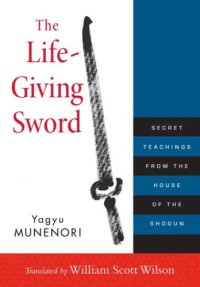
Ebook: The Life-Giving Sword: Secret Teachings from the House of the Shogun
The legendary seventeenth-century swordsman Yagyu Munenori was the sword instructor and military and political adviser to two shoguns—and a great rival to Miyamoto Musashi. Despite his martial ability and his political power, Munenori's life was spent immersed in Zen teachings. These teachings formed the framework for his deeply spiritual approach to sword fighting. Munenori saw in the practice of the sword a way to transform the student into a total human being. The Life-Giving Sword is Munenori's manifesto on his approach. His central themes are the "life-giving sword"—the idea of controlling one's opponent by spiritual readiness to fight rather than by actual fighting—and "No Sword," which is the idea that the mind must be free of everything, even the sword itself, in order to get to the place of complete mastery. Munenori's ideas are applicable not only to martial arts but to business and human relations as well.
From Publishers Weekly
Just in time to capitalize on the cinematic vogue for samurai epics comes this new translation of a classic 17th-century Japanese swordsmanship manual. Heavily influenced by Zen Buddhism, Munenori, a swordsmanship instructor to several Shoguns, downplays the training and extols the spiritual enlightenment and life lessons to be gained through martial arts. A few rules of thumb like "you attain the victory by having your opponent make the first move" and "it is dangerous to get any closer than one foot" could be useful in a sword fight, but actual combat maneuvers like Billowing Clouds, Flower Wheel and Sword of Mystery must be learned through "oral transmission" since "they are difficult to express in written words." (A lengthy appendix taken from another source, containing period illustrations and detailed but still opaque instructions on fighting moves, confirms this insight.) Instead of specific routines, Munenori emphasizes the attainment of No-Mind, the Zen version of "flow" in which one's swordplay proceeds without self-conscious thought. The book's philosophy, it must be said, is also pretty difficult to express in written words, and is conveyed through poetic imagery ("with a pilfered glance, the dragonfly evades the shrike") and mystic paradoxes ("that which is called existence is nothing other than non-existence, and that which is called non-existence is none other than existence.") Munenori's rambling exposition of it may lead readers to conclude that, whatever wisdom comes of a lifetime of sword fighting, it doesn't impart a polished literary sensibility. Fortunately, Wilson, translator of several samurai works, includes a substantial biography of Munenori that illuminates the political and cultural background of the samurai ethos and clarifies Munenori's doctrines for novice readers. Photos.
Copyright © Reed Business Information, a division of Reed Elsevier Inc. All rights reserved.
About the Author
William Scott Wilson is the foremost translator into English of traditional Japanese texts on samurai culture. His best-selling translations include Hagakure and The Book of Five Rings.
From Publishers Weekly
Just in time to capitalize on the cinematic vogue for samurai epics comes this new translation of a classic 17th-century Japanese swordsmanship manual. Heavily influenced by Zen Buddhism, Munenori, a swordsmanship instructor to several Shoguns, downplays the training and extols the spiritual enlightenment and life lessons to be gained through martial arts. A few rules of thumb like "you attain the victory by having your opponent make the first move" and "it is dangerous to get any closer than one foot" could be useful in a sword fight, but actual combat maneuvers like Billowing Clouds, Flower Wheel and Sword of Mystery must be learned through "oral transmission" since "they are difficult to express in written words." (A lengthy appendix taken from another source, containing period illustrations and detailed but still opaque instructions on fighting moves, confirms this insight.) Instead of specific routines, Munenori emphasizes the attainment of No-Mind, the Zen version of "flow" in which one's swordplay proceeds without self-conscious thought. The book's philosophy, it must be said, is also pretty difficult to express in written words, and is conveyed through poetic imagery ("with a pilfered glance, the dragonfly evades the shrike") and mystic paradoxes ("that which is called existence is nothing other than non-existence, and that which is called non-existence is none other than existence.") Munenori's rambling exposition of it may lead readers to conclude that, whatever wisdom comes of a lifetime of sword fighting, it doesn't impart a polished literary sensibility. Fortunately, Wilson, translator of several samurai works, includes a substantial biography of Munenori that illuminates the political and cultural background of the samurai ethos and clarifies Munenori's doctrines for novice readers. Photos.
Copyright © Reed Business Information, a division of Reed Elsevier Inc. All rights reserved.
About the Author
William Scott Wilson is the foremost translator into English of traditional Japanese texts on samurai culture. His best-selling translations include Hagakure and The Book of Five Rings.
Download the book The Life-Giving Sword: Secret Teachings from the House of the Shogun for free or read online
Continue reading on any device:

Last viewed books
Related books
{related-news}
Comments (0)